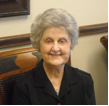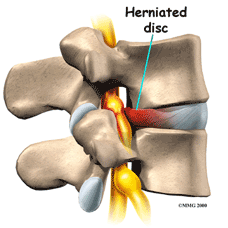STOP Living in Pain Today! • (480) 926-7100 • Call NOW For a FREE ConsultationContact Us
East Valley Spinal Decompression Center
|
|


"I Can Stand and Walk Straight For the First Time in 30 Years"
- Joe A.

"...the greatest gift I have
received in all my life...."
- Joyce B.

"I was unable to bend over enough to dress myself.... My back is completely restored"
- Robert H.

"If it wasn't for the doctor and spinal decompression I would not have been able to continue my job as a meat cutter"
- Leandro M.
Disc Herniations

The spinal disc is a soft cushion that sits between each vertabrae of the spine. The spinal discs are composed of a tough spongiform ring of cartilage (annulus fibrosus) with a more malleable center (nucleus pulposis). Like a shock absorber for a car, the disc is the shock absorber for the spine. When too much pressure is placed on the disc, it bulges or herniates. Think of it like a jelly doughnut… squeeze it too hard and the jelly comes out. That is called a Herniated Disc (Slipped Disc, Bulging Disc).
How Does a Herniated Disc Occur?
The discs cushion the spine from compressive forces, but are weak to pressure applied during rotational movements. That is why a person who bends to one side, at a bad angle to pick something up, may more likely herniate a spinal disc than a person jumping from a ladder and landing on his or her feet. Herniation of a disc occurs when the liquid center of the disc bulges outwards, tearing the external ring of fibers, extrudes into the spinal canal, and compresses a nerve root. This extruded liquid from the nucleus pulposus may cause inflammation and swelling of surrounding tissue which may cause further compression of the nerve root in the confined space in the spinal canal.
What causes symptoms of a herniated disc?
When the herniated disc ruptures and pushes out, the nerves may become pinched. When a herniated disc occurs, the space for the nerves is further diminished, and irritation of the nerve results. This irritation of the nerves going down the arms or legs can lead to the characteristic signs of a disc herniation including but not limited to shooting, electrical pain down the arms and legs and numbness and tingling in the hands and feet.
What are the symptoms of a herniated disc?
When the spinal cord or spinal nerves become compressed, they don't work properly. This means that abnormal signals may get passed from the compressed nerves, or signals may not get passed at all. Common symptoms of a herniated disc include:
- Electric, Stabbing, Shooting or Burning Pain
Pressure on the nerve can cause abnormal sensations, commonly experienced as electrical, sharp, shooting, or even "hot poker" pains. When the compression occurs in the neck (cervical) region, these symptoms go down your arms. When the compression is in the low back (lumbar) region, these symptoms go down your legs. - Tingling & Numbness
Patients often have abnormal sensations such as tingling, numbness, or pins and needles. These symptoms may be experienced in the same region as painful, shooting, stabbing pains. - Muscle Weakness
Because of the nerve irritation, signals from the brain may be interrupted causing muscle weakness. Nerve irritation can be tested by examining reflexes.
How Does Spinal Decompression Work?
Non-Surgical Spinal Decompression, not to be confused with linear traction, slowly lengthens and decompresses the spine, creating negative pressures within the discs.This reversal of pressure creates an intradiscal vacuum that helps to reposition bulging discs and pull extruded disc material back into place, taking pressure off pinched nerves. Spinal experts believe that nutrients, oxygen, and fluids are drawn into the disc to create a revitalized environment conducive to healing.
What are the Treatments Like?
At the beginning of each session, you will be comfortably fitted with a harness designed to achieve optimal decompression of the low back or neck. During a session of spinal decompression, you will notice a slow lengthening of your spine as your discs are gradually decompressed and relieved of pressure. The treatment process is safe and relaxing. While some patients with extensively injured discs have reported mild discomfort during the first few treatment sessions, their discomfort subsides upon subsequent visits. A patient safety switch provides an extra safety feature, allowing you to stop at any point should you feel discomfort. Each treatment session lasts approximately 30 minutes. Individual patient results may vary.
What is the Typical Treatment Protocol?
A typical spinal decompression treatment protocol consists of about 20-25 sessions over four to six weeks. Some conditions require fewer visits; some require more. Many patients report relief from their pain and other symptoms during the first few treatment sessions, and most experience dramatic pain relief after completion of their prescribed treatment program.
Why Is Spinal Decompression Different from Traction? Why are Some Spinal Decompression Tables Better Than Others?
While traction, physical therapy, and manipulation may reduce disc pressures to as low as 40 mm Hg, only spinal decompression has been shown to achieve negative pressures within the spine. It has been clinically proven that spinal decompression creates negative pressures as low as -110 mm Hg3 within the injured disc during the treatment session. Normally, pulls exerted on the spine trigger sensory receptors in the back to tighten the muscles surrounding the vertebrae and discs in an effort to protect them from injury,a mechanism in the body known as the proprioceptor response. Spinal Decompression bypasses this response by slowly pulling on the spine and relaxing the back over an extended period of time, allowing the spine to be repositioned without tension and without setting off the "Iock down" proprioceptor response. It is important for patients to make sure that they are treated on a high quality spinal decompression table and not an imitation spinal decompression table.
If you have more questions please go to the Frequently Asked Questions Section (FAQ's) or call us anytime.
How Do I Get Started?
Call Us At:
(480) 926-7100
To schedule an initial consultation with the Doctor nearest you to determine if you are a candidate for care with Spinal Decompression. After carefully studying your case history and exam findings, your Doctor will sit down and determine if you qualify for Spinal Decompression Therapy treatment. If you do qualify for care, your Doctor will explain their recommended plan of action for you. After answering any questions you may have about the recommended plan, you may begin your care.
Treat serious back pain, sciatica, herniated disc, degenerative or bulging disc, or spinal stenosis with non surgical spinal decompression. Learn more about this safe and easy back pain treatment offered by East Valley Spinal Decompression Center and all of our chiropractic services; read testimonials and spinal decompression reviews from many satisfied clients and residents of Gilbert, Mesa, Chandler, Tempe, and Apache Junction, Arizona.

©2008-2010 East Valley Spinal Decompression Center ![]()
![]()
![]()
![]() designed by jeff thomason, ce
designed by jeff thomason, ce
